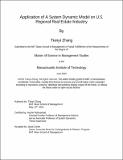Application of A System Dynamic Model on U.S. Regional Real Estate Industry
Author(s)
Zhang, Tianyi
DownloadThesis PDF (2.672Mb)
Advisor
Rahmandad, Hazhir
Terms of use
Metadata
Show full item recordAbstract
This research strives to explore and simulate the dynamics of regional real estate markets within the United States using the system dynamics methodology. Building upon the original model by John Sterman, the study expands it by introducing new structures related to construction-in-progress, unit prices, alternative funds, and sales. The model undergoes calibration utilizing historical data from 1975 to 2021, with a focus on its capacity to simulate key parameters such as start rate, construction-in-progress rate, construction rate, and price. Although calibration fitness demonstrates a reliable match for trends, it exhibits limitations in representing dynamics over short time periods and seasonality. Utilizing the calibrated model, the study generates forecasts for future real estate market trends under three scenarios: baseline, standard growth, and elevated interest rate. The forecast results emphasize the influential role of space demand, the effect of interest rates on prices, and the reinforcing feedback loop of future prices. The study highlights potential avenues for model enhancement and establishes a foundation for subsequent research.
Date issued
2023-06Department
Sloan School of ManagementPublisher
Massachusetts Institute of Technology